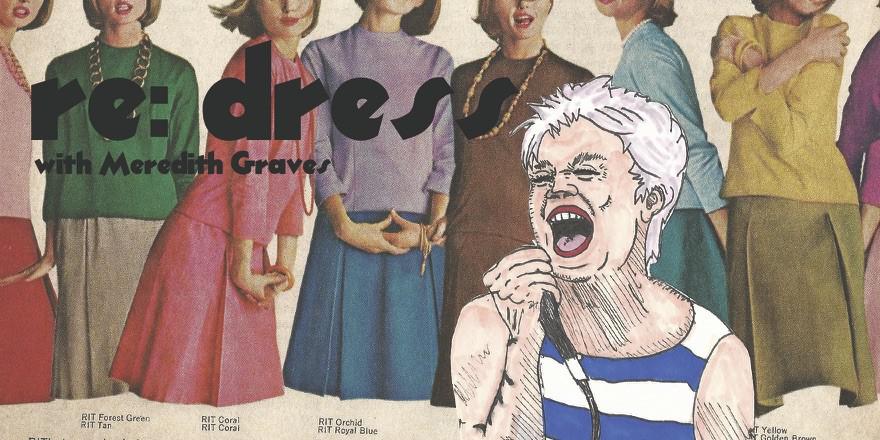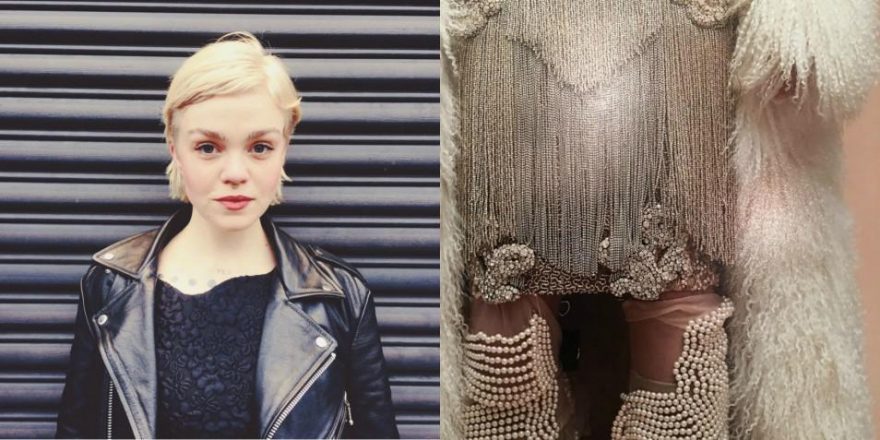“Be regular and orderly in your life like a bourgeois, so that you may be violent and original in your work.” — Gustave Flaubert
When I sat down and tried to write about Death Grips in a rigid, logical way, I kept coming back to such thoughts as “I wish I could smell like honey forever” and “If this were a movie, I could jump from my window to the roof of the building across the street.” Even with my sense of humor, I couldn’t do that to you (for the same reason I don’t give my friends cupcakes frosted with mayonnaise on April Fool’s Day).
What follows, instead, is a loose meditation on the connections one may make between Death Grips and the visual image (and the construction of images and their subsequent consumption).
 Death Grips’ music is purposely unattractive. Death Grips’ appearance is unconcerned with attraction (which is different than being purposely unattractive). This is what they look like (the three in the back; we’ll get to the other guy later).
Death Grips’ music is purposely unattractive. Death Grips’ appearance is unconcerned with attraction (which is different than being purposely unattractive). This is what they look like (the three in the back; we’ll get to the other guy later).
Last year a zip file appeared, hosted on the Death Grips website, of an album by an unknown band called The I.L.Y.s. The first track on I’ve always been good at true love is called “The Sickest Fuck of Them All.” Users of /r/deathgrips pointed out that this phrase first appeared on a shirt in Death Grips’ video for “I’ve Seen Footage.” This is probably the most exciting connection you can make between Death Grips and clothing, because they’ve never really done much else with it as a medium.
Death Grips, who generally seem to exist outside of rational behavior and unspoken social laws, are actually very predictable in this one way: they always more or less look like nothing. They can’t be in any way understood intuitively on sight. They create images rather than existing as an image (most bands are not like this); they’re more subject than object.
Photographer Brian Sheffield shot photos of the band for Self-Titled magazine.
Sheffield writes on his blog: “Andy (the dude in the middle) has a cell phone jammer in his hand. He was carrying it around the entire shoot. Made me laugh a few times when he made random people drop their calls. He did it to me also. Funny guy.”
Could a cell phone jammer be considered a luxury fashion item? Just this week, a man who some are now calling a folk hero was arrested in Chicago for using a cell phone jammer on public transportation:
The epic saga began in late 2015, when Chicago residents noticed their calls being dropped or lacking service altogether while traveling on area trains. Chicago IT worker Brain Raida outed Nicholl as the cause after sharing a photo on Reddit of the man with the jammer in one hand and a can of beer in the other.
Many people’s primary argument against high fashion is that it’s elitist, too expensive, and available only to a few. The same could be said about silence.
Death Grips released an album on a major label, then spontaneously self-released the follow-up, resulting in their being dropped. They’ve formally announced breakups, raking in eulogistic think-pieces days before announcing world tours. They book shows, play some, and don’t show up to others:
This no-show was planned, with the group sending along a children’s drum kit, which was set up onstage in front of a screen showing a fan suicide note sent to the band via email. Pre-recorded music played over the house speakers. When the announcement came that there would be no performance, the crowd was incensed. The drums were destroyed in protest, and Death Grips caused the stir that they so clearly desired.
It was an unpredictable experience, available for a limited window, ugly and expensive in a Russian-roulette sort of way, akin maybe to clothing label Enfants Riches Déprimés and going to the movies to see whichever Saw it was where the guy gets his jaw ripped off by a bear trap.
At the time of writing, the band has released a thirty-two-minute video, called “Interview 2016,” featuring instrumental music over unrelated footage of the band first playing a song, then being interviewed by a man who looks like Max Headroom.
Selling a Shirt with a Shirt on It: This is really what kills me.
The guys in Death Grips don’t wear shirts that say anything, seemingly ever, but all of their band’s shirts say things. One of their shirts is a picture of a shirt. They don’t care to sell a good-looking shirt (most of their shirts use deplorable fonts, indecipherable images and generally look like shit). They wouldn’t wear their own shirts. Usually two-thirds of them don’t even wear shirts. And not one of their shirts says “Death Grips.”
In Vonnegut’s “Harrison Bergeron,” by 2081, far-reaching government programs set in place by the Handicapper General ensure everyone in our society is meaningfully debilitated according to their strengths, so as to create a world where all people are uniform in intelligence, physical ability, etc.
This practice is employed to stop comparison and interpersonal competition. Likewise, all people are dressed similarly and neutrally, even having black bags placed over their faces if they are deemed too attractive. Everyone is exactly as good as everyone else (that is, all things are seemingly low-quality and abundant).
This means that displays of excellence or beauty are incredibly risky, and involve acting out in dramatic, violent ways. The titular Harrison, strikingly handsome in addition to being “a genius and an athlete” who excels in every way imaginable, is given the most serious handicaps:
And to offset his good looks, the H-G men required that he wear at all times a red rubber ball for a nose, keep his eyebrows shaved off, and cover his even white teeth with black caps at snaggle-tooth random.
Harrison escapes from the jail where he was placed on suspicion of plotting to overthrow the government. He completely snaps on live television, tearing off the immense weights and scrap metal designed to slow him down and the earphones that deliver periodic awful sounds to prevent him from thinking too hard or too consistently. Prior to his escape, he looks like everyone else: simple, invisible, burdened with the pressure of appearing normal. Only after he strips away his common uniform, shirtless and unburdened and utterly detached from the self that blended in with society, does he dance, scream and ascend.
on the thirty-second day i did not give a fuck
A. Sabotaging L.A. Reid: years after dropping the band from his label, producer L.A. Reid’s decision to do a promotional Reddit AMA for his memoir led to his being harassed endlessly by Death Grips fans wanting more information about what it was like to work with them (though their neutrality and secretiveness is the cornerstone of their identity, fans still want more, despite the fact that more knowledge would fundamentally change their relationship to the band).
B. In my opinion, there are basically two core archetypes of punk masculinity: the power electronics Marshstepper Kewpie in the black sweater and little Udo Kier glasses, or the two shirtless, screeching, wild-eyed sun god greaseballs who barely ever wear clothes.
C. I mean, you guys barely wear clothes, anyway. Why am I writing this?
“Stefan went straight into the bathroom and literally just ripped it, like graffiti, like tore into the stalls, carving DEATH GRIPS all over the stalls of the brand new Sony offices.”
Members of /r/deathgrips/ are at odds as to whether or not it’s acceptable to inquire after the personal life of singer MC Ride/Stefan Burnett. He is largely a plain shirt; the only easily validated fact about him other than his career as a painter is that he’s intensely private. His lyrics, voice and performance are so nihilistic and off-putting, it almost seems kooky for people to be interested in his deep inner workings. There’s a chance he could be a psychopathic killer; there’s an equal chance it could all be one long performance.
It is comparable to the cultural debate about whether or not our desperate need to unmask Elena Ferrante is normal. There are notable differences: to my knowledge, Ferrante has never been seen and has not validated her identity, whereas Ride’s participation in the group is wildly public. But in both cases, it begs the question: must we know who a person is in order to enjoy their work?
Death Grips hasn’t really done an interview since 2012, which is probably for the best. But when they did, someone in the band (maybe mistakenly) said:
Lyrically, Death Grips represent the glorification of the gut…the id…summoned, tapped, and channeled before being imprisoned and raped by the laws of reason…. All songs are written collectively and then maximized through painstaking attention to detail. We practice the art of deconstruction with the devotion of possessed fanatics. Both idealists and pessimists live in delusional fantasies rooted in their incapacity to deal with the way of things. We are realists. Anyone who feels safe is a brainwashed lamb ready for the slaughter.
(Header art by Dan Schmatz)








